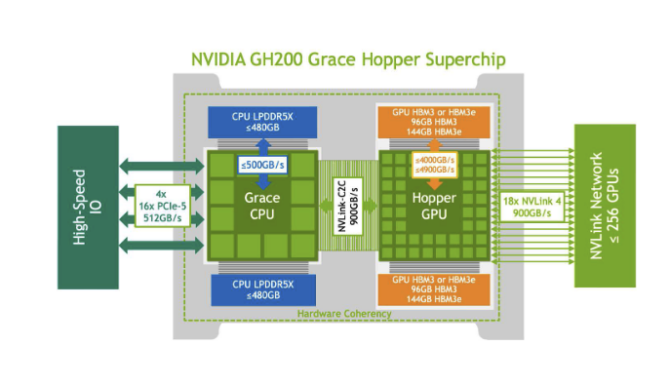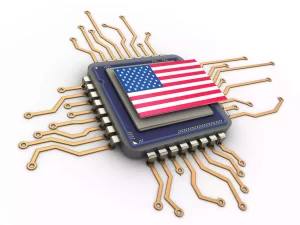Introduction
In the dynamic realm of artificial intelligence (AI) and high-performance computing (HPC), the race for supremacy is relentless. Recently, Nvidia has been making significant strides in reshaping the landscape of AI supercomputing, positioning itself as a formidable contender with its innovative Grace Hopper GH200 CPU+GPU combo.
Nvidia claims significant progress in establishing itself as the preferred hardware provider for AI supercomputers, extending beyond just GPUs. The company highlights the adoption of its GH200 Grace Hopper CPU+GPU combination in nine supercomputing facilities globally, signaling Nvidia’s emergence as a competitor to CPUs from AMD and Intel in driving some of the most advanced AI systems worldwide.
This powerful fusion of processing units marks a pivotal moment in the industry, challenging the conventional dominance of CPUs from established giants like AMD and Intel.
Follow us on LinkedIn for everything around Semiconductors & AI
The Rise of Grace Hopper GH200
Nvidia is promoting a “new wave” of Arm-powered supercomputers, potentially posing a threat to Intel’s dominance in the data center realm. The Grace Hopper GH200 combines a 72-core Arm-based Grace CPU with an H100 Hopper GPU, forming what Nvidia terms a Grace Hopper Superchip. Although unveiled in May 2023, Nvidia surprised observers in August by announcing an upgrade of its memory from HBM3 to HBM3e, despite the product’s recent launch. While the deployment of Grace Hopper in servers has been limited thus far, likely due to its novelty in the market and the ongoing competition between Arm-based CPUs and x86 architecture, Nvidia seems determined to convey that the landscape is evolving.
The GH200 boasts a unique architecture, featuring a 72-core Arm-based Grace CPU coupled with an H100 Hopper GPU. This synergy creates what Nvidia terms as the “Grace Hopper Superchip,” heralding a new era of computational prowess.

Unveiled in May 2023, the Grace Hopper GH200 garnered attention not only for its cutting-edge specifications but also for its swift evolution. In a surprising move, Nvidia upgraded its memory from HBM3 to HBM3e just months after its initial release, demonstrating a commitment to continuous improvement and adaptability.
Read More: Paradigm Shift in AI: First Commercial Neuromorphic Computer Arrives – techovedas
Global Deployment and Impact
Global deployment of these systems includes countries such as France, Poland, Switzerland, Germany, Japan, and the United States. Prestigious institutions like the University of Illinois Urbana-Champaign and the University of Bristol in the UK host notable installations.
Nvidia’s push for Arm-based CPUs signals a paradigm shift in AI infrastructure.
The allure of superior efficiency and performance with Grace Hopper GH200 has attracted nations aiming to enhance their AI capabilities.
This has led to the concept of “sovereign AI,” driven by geopolitical considerations and the pursuit of technological independence.
Read More: OpenAI Unveils GPT-4o: A Game-Changer in AI Technology – techovedas
Performance and Efficiency
Benchmarking studies have shed light on the performance and efficiency of Grace Hopper GH200 compared to traditional x86 installations. Grace may not outperform Intel-based systems in sheer performance, but its strength lies in efficiency and thermals. This makes Nvidia an attractive option for organizations focused on energy efficiency and operational sustainability in AI deployments.
Read More: Bigger vs. Better: Can LLaMa 3 Size Overpower Mistral 7B Accuracy? – techovedas
Future Outlook
The development of these systems is driven by nations’ desire to nurture AI capabilities, known as “sovereign AI.” This involves countries establishing their own AI infrastructure to process data on domestically managed machines, supervised by local personnel. Another key factor is the Arm-based design of Grace, which offers improved efficiency over traditional x86 setups. In February, initial high-performance computing (HPC) benchmarks for Grace were released. While it didn’t surpass Intel-based systems in raw performance, it showed superior efficiency and thermal management, vital for large-scale deployments.
Read More: $120 Million: U.S. Government Grants Awarded to Bloomington Chipmaker From CHIPS Act – techovedas
Conclusion
Nvidia’s Grace Hopper GH200 redefines AI supercomputing. It challenges existing norms and sets the stage for a new era of computational excellence.
Countries and institutions are embracing sovereign AI and prioritizing computing efficiency.
Nvidia is positioned to lead the charge towards a smarter, sustainable future.








